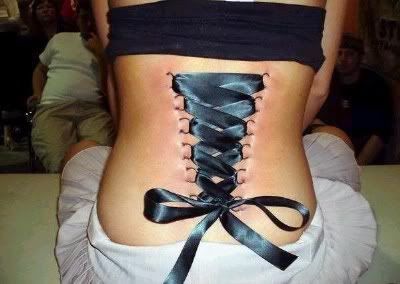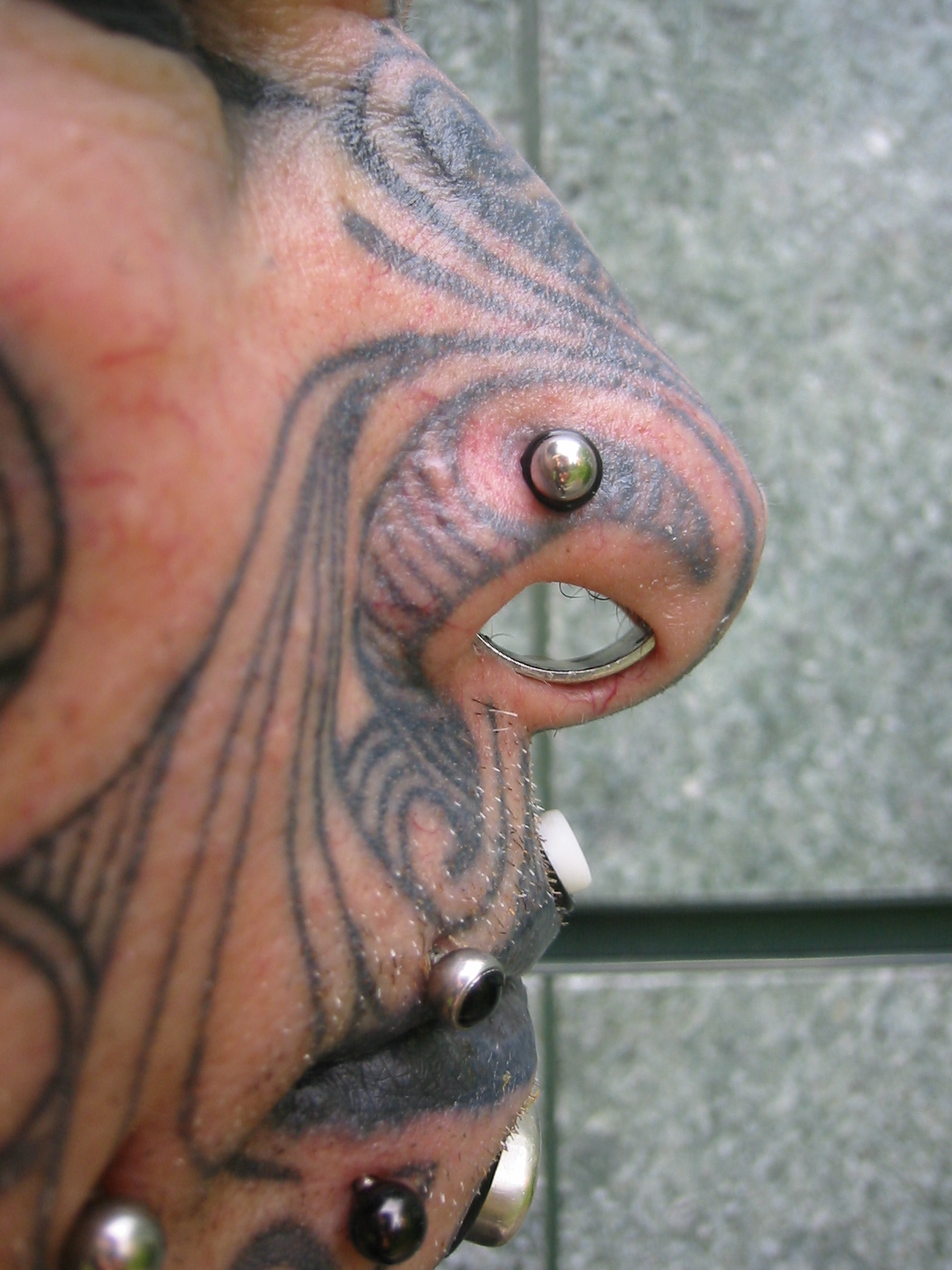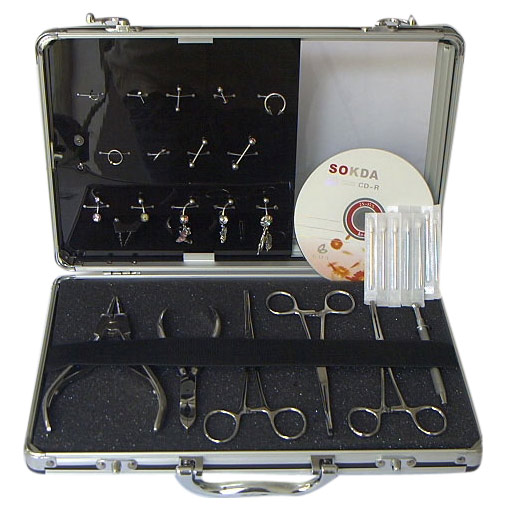
Body piercing (defined as any piercing beyond the standard earlobe piercing) has become such a popular form of body modification that between five and ten percent of the population of the United States has indulged in at least one form of it at some time in their lives. In most cases, once a person gets a body piercing, they follow the first one with more. There are lots of considerations; however, for making sure that your body piercing is done safely so that you don’t end up with either an infection or a poorly done piercing that could leave an unsightly scar.
It ain’t ear piercing, honey…
The procedure for a good body piercing isn’t the same is for getting your earlobes pierced. Most earlobe piercings that you see done in a mall or jewelry store involve using a piercing gun that quickly shoots the actual earring post through the earlobe. This may be fine for an area of the body that has soft tissue and is easily pierced, but it isn’t a good idea for other parts of the body for a few reasons.
First, it isn’t as accurate as a needle, so lining it up won’t always work. Just as with any gun, there is a recoil that will make the aim inaccurate. Second, the force of the gun will cause bruising and damage to the skin that isn’t necessary and will slow the healing process. Third, a piercing gun can’t be sterilized completely, so there is a higher risk of infection. The message is clear –- never get a body piercing done with a piercing gun. Always go to a professional who follows procedures approved by the Association of Professional Piercers (APP).
Once you get to the piercing parlor, there are several steps to the body piercing process that will take place to ensure both the success of the piercing and your health and safety. Each of these steps should be followed and nothing skipped.
Getting the preliminaries out of the way
You must be comfortable in the environment and comfortable with your piercer before moving ahead with anything. If he or she attempts to rush you through the procedure without answering your questions or putting you at ease, do not continue. This is a long-term commitment you are making, so it’s up to you if you want to go through with it.
There is paperwork to be filled out, and don’t let a piercing parlor tell you otherwise. A good piercing studio always keeps accurate records to ensure the health and safety of their clients. If there would ever be a question of contamination or some other health hazard, they must be able to contact you. If you are a minor, they must have the signature of your parent or guardian, who must be present at the time of the piercing.
Sterilization –- the only route to safe body piercing
Sterilization is all-important in body piercing –- the piercing area must be sterile, the piercer’s hands must be sterile, the tools used must be sterile, and the piercing needle must be sterile.
A separate area for sterilization should be available in the piercing parlor where a steam heat autoclave is operational. The autoclave is the only approved sterilization device that can sufficiently heat tools such as forceps to a high enough temperature to kill all bacteria. Before beginning any piercing, all tools will be sterilized in an autoclave and laid out carefully on a clean tray. After this, they will not be touched until your piercing begins, and then only by your piercer when he has safely cleaned and gloved his hands, just as a surgeon would.
You can’t be too clean
 The piercing chair or table will also be cleaned, usually by being wiped down thoroughly with an antibacterial spray and disposable cloths or paper towels to prevent recontamination. You will not be allowed to enter and prepare for your piercing until the area has been prepped and sterilized.
The piercing chair or table will also be cleaned, usually by being wiped down thoroughly with an antibacterial spray and disposable cloths or paper towels to prevent recontamination. You will not be allowed to enter and prepare for your piercing until the area has been prepped and sterilized.
The needles used for body piercing are sterile and individually packaged, and no reputable piercer will ever use a needle that has already been used once. When you are pierced, the sterile needle’s package should be opened in your presence just before your piercing. The same is true of your starter jewelry -– it should be sealed in sterile packaging and only opened in your presence.
The piercer will wash his hands and wrists with an antibacterial liquid soap and dry them before donning disposable gloves. At this point, he will be ready to begin your piercing.
Prep work means straight piercings and fewer complications
With properly gloved hands, your piercer will first check the area you want pierced to determine if you are really a candidate for the type of body piercing you’re seeking. In some cases, he may tell you that the conditions aren’t appropriate.
For instance, if there is damage to the cartilage or heavy scarring in the area you want pierced. He will also tell you if you have a current cut or skin condition that means you should postpone piercing. If this is the case, in order to protect your health and prevent possible problems down the line, he will not go any farther with the procedure. If everything looks fine, he’ll tell you so and you’ll move on to the next step.

- He’ll change to a fresh pair of gloves after having handled your skin to examine the area.
- He will clean the area to be pierced with an antibacterial solution.
- He will mark the area to be pierced with a sterile, disposable marker.
- You’ll have the opportunity to check the marking (in a mirror if necessary) before he proceeds to the piercing stage.
- He will ask you if you are ready for the piercing procedure and allow you a moment to get comfortable.
- He will arrange his tools at hand and open the sterile package with the piercing needle.
And now, you’re ready for the real deal –- the piercing itself!
But first, a word about those piercing needles...
Piercing needles are not your average sewing needle or push-pin. Piercing needles are highly specialized and were designed specifically to pierce the flesh while causing the least amount of pain possible. They also help encourage faster and cleaner healing than a regular needle.
These needles also come in a variety of gauges suited for specific types of piercings. For instance, if you are getting a nipple pierced, the piercer will probably not want to use anything smaller than a 12 gauge (the smaller the gauge, the larger the needle), while a lip or nostril could be pierced with a 14 or 16 gauge. Thicker gauges prevent migration in areas prone to this movement of the jewelry, and prevent tear-out of piercings in more delicate flesh.
Piercing needles are made from surgical steel –- the same material that hospital scalpels and lancets are made from. This ensures that they are biocompatible with all skin types and won’t cause an allergic reaction. They are also extremely sharp because they are laser cut with precision edges so that they slice cleanly through the skin without tearing or pulling. The piercing needles are hollow rather than solid so that they actually cut a tiny hole through the skin being pierced rather than punching through the skin.
These hollow needles leave a clean-edged, precise hole in the flesh that will heal relatively quickly, while a regular needle (which is much duller by comparison) actually pushes its way through the skin, tearing and bruising the skin along the way.
This is why a professional piercing needle provides a much less painful piercing with minimal bruising, and is much safer and easier for your body.
The main event –- the body piercing
The basic procedure is the same for most piercings, but all piercers have their own way of handling the process. Some piercers will clamp the area with forceps to stabilize the area before putting the needle through, while others prefer to use a steady hand and their own eyes to guide the needle. If the person being pierced seems like they may flinch, it is more likely the forceps or surgical pliers of some type will be used to steady the area and hold the skin in place. This doesn’t hurt, and is simply to make sure you don’t get a crooked placement.
When the needle is lined up with the marking, the piercer will ask one last time if you are ready, and then quickly push the needle through. Some piercers use a cork as a backing, others don’t. This usually only takes a moment and feels like someone is pinching the skin hard. In most cases, the build-up to the moment is far worse than the actual piercing. Areas that are more sensitive include the genital area and the bridge of the nose.
Starter jewelry needs to be high quality
After the needle is removed, the starter jewelry is immediately put into place. One of the most important things to know about starter jewelry is that it is being put into an open wound, which is what a fresh piercing really is. Obviously, you don’t want your starter jewelry to be something that can cause an allergic reaction or infection.
There are three materials recognized by professional piercers as acceptable for starter jewelry for their high quality, purity and their low incidence of allergic reactions:
- Surgical Steel
- Titanium
- 14K or 18K gold
Other materials are more likely to cause either an allergic reaction, rejection of the piercing by your body, or migration of the piercing.
 Starter jewelry is generally a captive bead ring or barbell. The piercer will choose an appropriate size for the area that is slightly larger than what you would normally wear to allow for some swelling, which is normal for the first several days after a new piercing. He will screw the ends onto the new jewelry and make sure it is securely in place.
Starter jewelry is generally a captive bead ring or barbell. The piercer will choose an appropriate size for the area that is slightly larger than what you would normally wear to allow for some swelling, which is normal for the first several days after a new piercing. He will screw the ends onto the new jewelry and make sure it is securely in place.
At this point, the piercer will remove this set of gloves and put on another fresh set, clean the area around the new piercing and examine it one last time. He will let you take a look at your new body jewelry while he explains the aftercare and any potential problems you should watch for. He will also give you a sheet of detailed aftercare instructions to take home with you.
Before you leave, take a few moments to relax either in the piercing room or the waiting room, as sometimes the adrenalin rush and its aftermath can leave you feeling a bit light-headed. Once you feel steady and sure of yourself, it is a good idea to get something like fruit juice to drink or a light snack. Your piercing is done!
What if I want to try body piercing myself?
If you love body modification, you may be considering piercing yourself. It’s really not a good idea for a number of reasons. If you want to try piercing, do it the right way -- become a fully trained, licensed professional. Without the proper training and an understanding of proper sterilization techniques you risk scarring, infection, and permanent damage to the area.
Using makeshift piercing tools like sewing needles is also a great risk because they simply cannot be sterilized properly. Even heating over an open flame (such as a lighter) will not kill all bacteria. The only guaranteed way to kill all germs is with an autoclave or by using packaged, sterile surgical needles. Even then, the entire area and all tools must be sterilized properly.
 If you are truly interested in piercing, consider it not as a hobby or a momentary activity but as a career. Becoming an apprentice at a piercing parlor means learning proper technique and learning a trade at the same time, combining your interests with a way to make a living.
If you are truly interested in piercing, consider it not as a hobby or a momentary activity but as a career. Becoming an apprentice at a piercing parlor means learning proper technique and learning a trade at the same time, combining your interests with a way to make a living.
An apprentice usually trains for at least a year under a licensed, professional piercer learning all aspects of sterilization, piercing and customer service. In many states they are also required to take courses in first aid, blood borne pathogens, anatomy and other Health and Safety standards and practices. You will observe piercings and work with the sterilization process for several months before actually doing any piercings, but when you do pierce you will be doing it properly and professionally. A good place to find out more information is through the Association of Professional Piercers’ website at www.safepiercing.org.
 Body piercing is truly ancient with the earliest recorded piercing appearing on a frozen mummy found in an Austrian glacier in 1991. The body had several expanded ear piercings measuring between 7mm and 11mm.
Body piercing is truly ancient with the earliest recorded piercing appearing on a frozen mummy found in an Austrian glacier in 1991. The body had several expanded ear piercings measuring between 7mm and 11mm. Roman soldiers are also said by many to have had their nipples pierced as some sort of right of passage but there is little or no evidence of this. In fact many articles will state that the piercing was used to somehow ‘hold their cloaks in place’. Anyone who has had a nipple piercing will tell you how uncomfortable this would probably be if worn for any length of time and let’s think about it, there would be far better ways to fasten a cloak. The story seemed to originate from pamphlets published by Doug Malloy in the 70’s to help drum up business for his piercing studio. Many of the pamphlets published by him contained inaccurate or fictional information although there is little doubt that he was one of the pioneers of modern day body piercing in the USA.
Roman soldiers are also said by many to have had their nipples pierced as some sort of right of passage but there is little or no evidence of this. In fact many articles will state that the piercing was used to somehow ‘hold their cloaks in place’. Anyone who has had a nipple piercing will tell you how uncomfortable this would probably be if worn for any length of time and let’s think about it, there would be far better ways to fasten a cloak. The story seemed to originate from pamphlets published by Doug Malloy in the 70’s to help drum up business for his piercing studio. Many of the pamphlets published by him contained inaccurate or fictional information although there is little doubt that he was one of the pioneers of modern day body piercing in the USA. Piercing in Europe has been around since at least the 16th century with ear piercing being especially popular during Elizabethan times. More ‘exotic’ piercings grew in popularity during Victorian times. Prince Albert is said to have had his penis pierced to allow attachment so that less movement showed when dressed, although little hard evidence exists to support this. However, he still had one of the most popular male genital piercing named after him – The Prince Albert.
Piercing in Europe has been around since at least the 16th century with ear piercing being especially popular during Elizabethan times. More ‘exotic’ piercings grew in popularity during Victorian times. Prince Albert is said to have had his penis pierced to allow attachment so that less movement showed when dressed, although little hard evidence exists to support this. However, he still had one of the most popular male genital piercing named after him – The Prince Albert. With eyebrow piercing appearing on members of bands such as Take That and other popular musicians quickly following, the public were quick to jump on the bandwagon and a huge boom in facial and the ever-popular belly button piercing resulted. With the plethora of jewellery now available for all piercings to make many look truly stunning there seems to be no slowdown in its popularity in sight.
With eyebrow piercing appearing on members of bands such as Take That and other popular musicians quickly following, the public were quick to jump on the bandwagon and a huge boom in facial and the ever-popular belly button piercing resulted. With the plethora of jewellery now available for all piercings to make many look truly stunning there seems to be no slowdown in its popularity in sight.


















